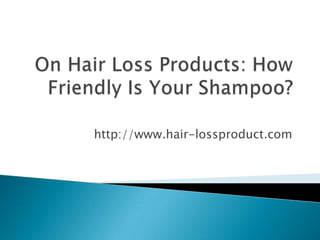On hair loss products
- 2. As a part of our daily hair care regimen, we use shampoo to remove dirt, excess sebum, dandruff, and pollutants from our scalp; improve hair condition; protect our hair from damage; and serve such other functions. There are several types of shampoos, each are classified according to function, to wit: anti-dandruff, medicated, 2-in-1 shampoo, mild baby shampoo, basic beauty shampoo, premium condition shampoos, etc. But whether you are using regular hair loss products or specialized shampoos, do you know that these can contain potentially harmful ingredients? Check the label and be wary of the following ingredients in a shampoo before buying it.
- 3. ï― Sodium lauryl sulfate is a potent washing surfactant, more exactly a foaming agent that may cause certain health risks and is potentially carcinogenic. There is a variation of SLS called sodium laureth sulfate (SLES) which is often said to be similarly harmful as SLS. The OSHA, NTP, and IARC, however, had already said that the statement is exaggerated. ï― In the manufacturing of SLES, there is a chance it is contaminated with 1,4-Dioxane, the unwanted by-product. However, only the exposure to large amounts of this compound can cause health risks.
- 4. ï― Phthalates are plasticizers which are also classified as potentially carcinogenic. They are often present in perfumes to provide fragrance. However, aside from being potentially carcinogenic, they can also intoxicate the immune system and cause birth defects, liver cancer, and hormonal disruptions.
- 5. ï― This chemical is a volatile organic compound that has always been suspected to be carcinogenic. When inhaled or ingested, it can be seriously toxic to the respiratory system. Oftentimes, it can be present in ingredients such as DMDM hydantoin, diazolidinyl urea, imidazolidinyl urea, quaternium-15, and bronopol.
- 6. ï― DEA and TEA are wetting agents so that the shampoo can create richer soapsuds. DEA and TEA can react with nitrites which are used as preservatives. The reaction results in the formation of a carcinogenic compound called nitrosamines. ï― Itâs always precautionary to look at the ingredients of your shampoo or any other product you use, for that matter, since what you donât know might harm you.





